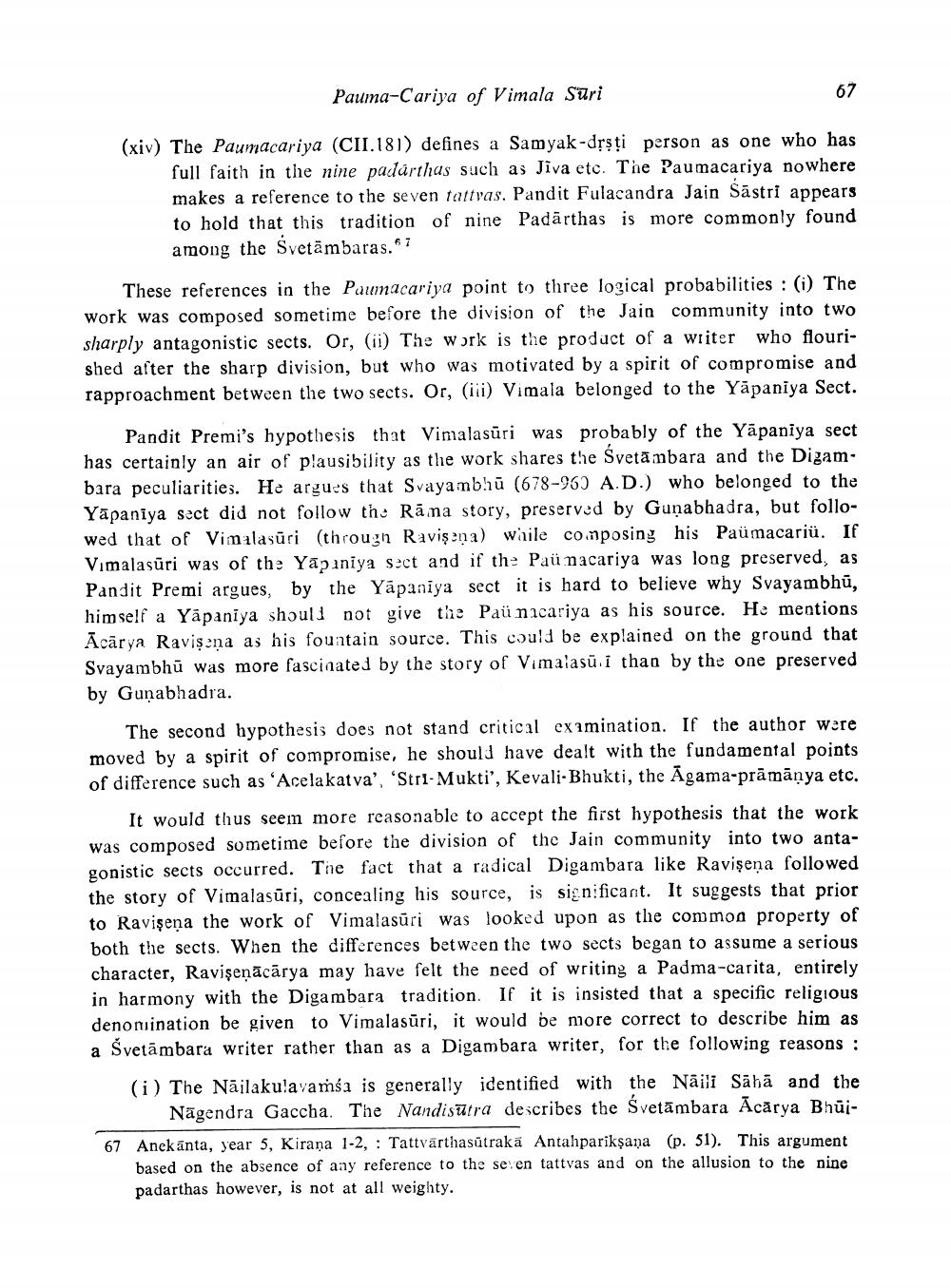________________
Pauma-Cariya of Vimala Suri
(xiv) The Paumacariya (CII.181) defines a Samyak-drsti person as one who has
full faith in the nine padárthas such as Jiva etc. The Paumacariya nowhere makes a reference to the seven tattvas. Pandit Fulacandra Jain Sāstri appears to hold that this tradition of nine Padārthas is more commonly found among the Svetämbaras. 7
These references in the Paumacariya point to three logical probabilities : (i) The work was composed sometime before the division of the Jain community into two sharply antagonistic sects. Or, (ii) The work is the product of a writer who flourished after the sharp division, but who was motivated by a spirit of compromise and rapproachment between the two sects. Or, (iii) Vimala belonged to the Yāpaniya Sect.
Pandit Premi's hypothesis that Vimala sūri was probably of the Yāpaniya sect has certainly an air of plausibility as the work shares the Svetāmbara and the Digambara peculiarities. He argues that Svayambhū (678-960 A.D.) who belonged to the Yapaniya sect did not follow the Rāna story, preserved by Gunabhadra, but followed that of Vimalasūri (through Ravişena) while composing his Paümacariü. If Vimalasūri was of the Yapıniya sect and if the Paünacariya was long preserved, as Pandit Premi argues, by the Yāpaniya sect it is hard to believe why Svayambhū, himself a Yapaniya should not give the Paü nicariya as his source. He mentions Ācārya Ravişena as his fountain source. This could be explained on the ground that Svayambhū was more fascinated by the story of Vimalasū i than by the one preserved by Gunabhadra.
The second hypothesis does not stand critical examination. If the author were moved by a spirit of compromise, he should have dealt with the fundamental points of difference such as 'Acelakatva', 'Stri-Mukti', Kevali-Bhukti, the Agama-prāmānya etc.
It would thus seem more reasonable to accept the first hypothesis that the work was composed sometime before the division of the Jain community into two antagonistic sects occurred. The fact that a radical Digambara like Ravişeņa followed the story of Vimalasūri, concealing his source, is significant. It suggests that prior to Ravişeņa the work of Vimalasūri was looked upon as the common property of both the sects. When the differences between the two sects began to assume a serious character, Ravişeņācārya may have felt the need of writing a Padma-carita, entirely in harmony with the Digambara tradition. If it is insisted that a specific religious denonination be given to Vimalasūri, it would be more correct to describe him as a Svetāmbara writer rather than as a Digambara writer, for the following reasons :
(i) The Nāilakulavamsa is generally identified with the Nāji Sāhā and the
Nagendra Gaccha. The Nandisutra describes the Svetāmbara Ācārya Bhūi67 Anekanta, year 5, Kirana 1-2, : Tattvärthasūtraka Antahpariksaņa (p. 51). This argument
based on the absence of any reference to the se: en tattvas and on the allusion to the nine padarthas however, is not at all weighty.




